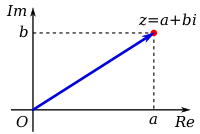Real and imaginary parts

Let's imagine you have a toy car that can only move forwards and backwards on one straight line. You can tell where it is on that line by measuring the distance it has traveled from a starting point.
Now, let's pretend that you have a magical power that allows you to move that toy car not only forwards and backwards on that line, but also left and right. Suddenly, you can no longer just use one measurement to know where the toy car is. You now need two measurements: one to tell you how far it is from the starting point, and another to tell you how far it is from the left/right axis.
In the world of math, this is where the concept of real and imaginary numbers comes in. In simple terms, a real number is just like the toy car moving forwards and backwards on the original line. It only needs one measurement to know where it is. An imaginary number, on the other hand, is like the toy car moving left and right on a new axis. It needs a second measurement to know where it is.
When we put these two kinds of numbers together, we get something called a complex number. A complex number is made up of a real part and an imaginary part, like two measurements for the toy car. We write a complex number like this: a + bi, where a is the real part and bi is the imaginary part.
So, just like you need both measurements to know where the toy car is, we need both the real and imaginary parts to fully understand a complex number. And just like adding or subtracting distances on the toy car's line, we can add or subtract complex numbers by adding or subtracting their real and imaginary parts separately.
Now, let's pretend that you have a magical power that allows you to move that toy car not only forwards and backwards on that line, but also left and right. Suddenly, you can no longer just use one measurement to know where the toy car is. You now need two measurements: one to tell you how far it is from the starting point, and another to tell you how far it is from the left/right axis.
In the world of math, this is where the concept of real and imaginary numbers comes in. In simple terms, a real number is just like the toy car moving forwards and backwards on the original line. It only needs one measurement to know where it is. An imaginary number, on the other hand, is like the toy car moving left and right on a new axis. It needs a second measurement to know where it is.
When we put these two kinds of numbers together, we get something called a complex number. A complex number is made up of a real part and an imaginary part, like two measurements for the toy car. We write a complex number like this: a + bi, where a is the real part and bi is the imaginary part.
So, just like you need both measurements to know where the toy car is, we need both the real and imaginary parts to fully understand a complex number. And just like adding or subtracting distances on the toy car's line, we can add or subtract complex numbers by adding or subtracting their real and imaginary parts separately.
Related topics others have asked about:
